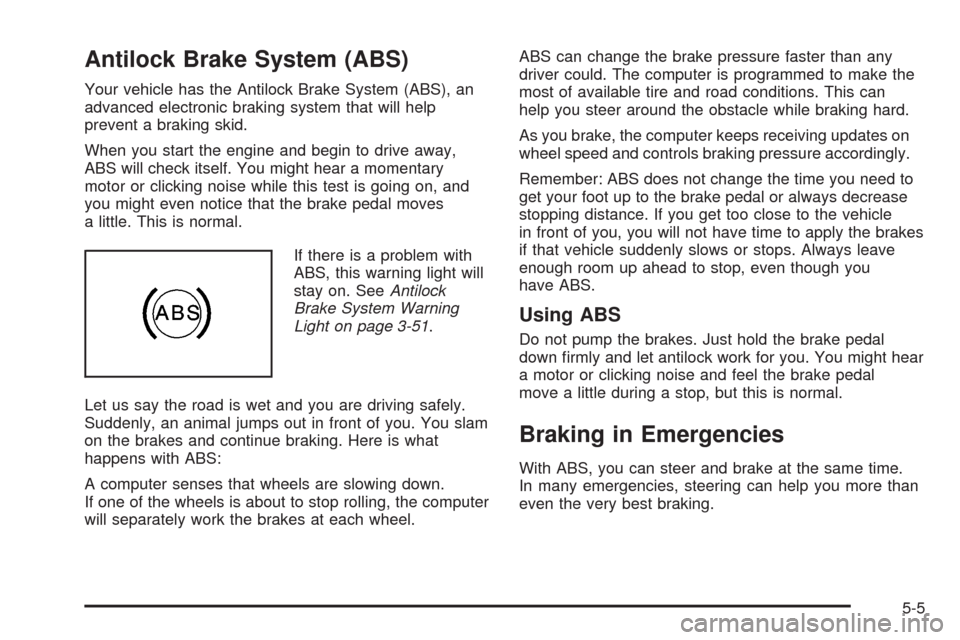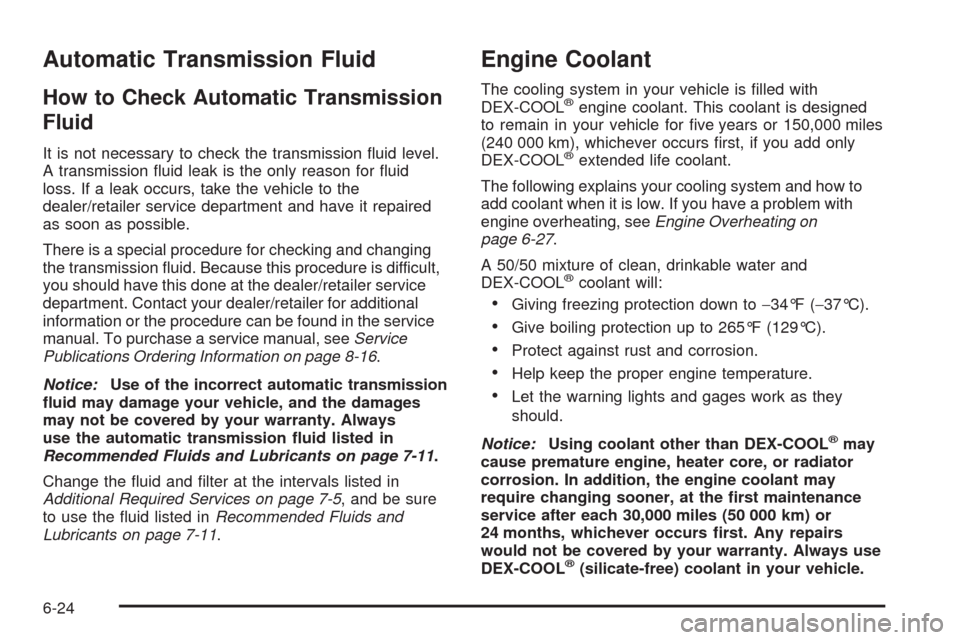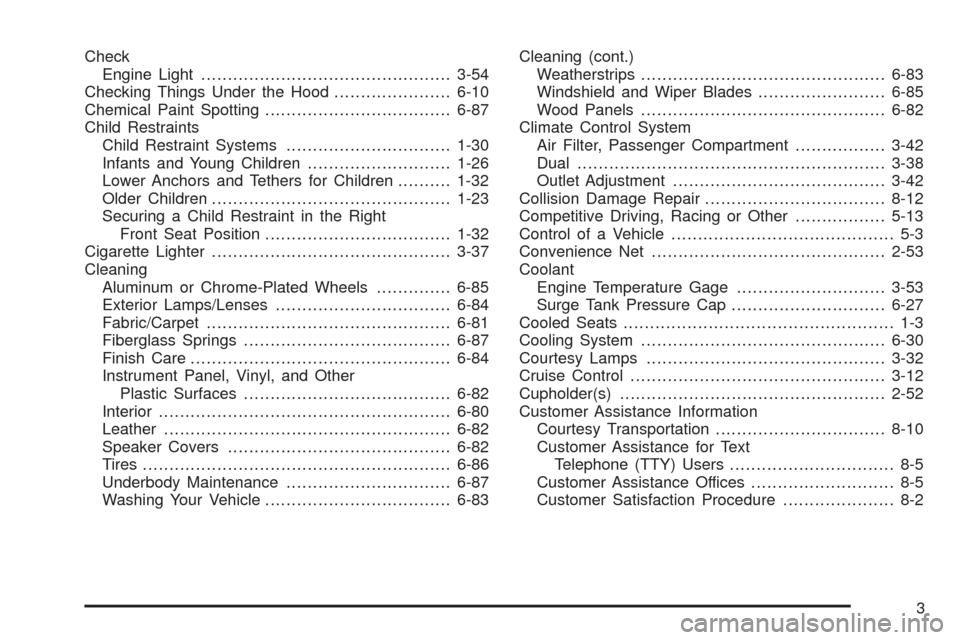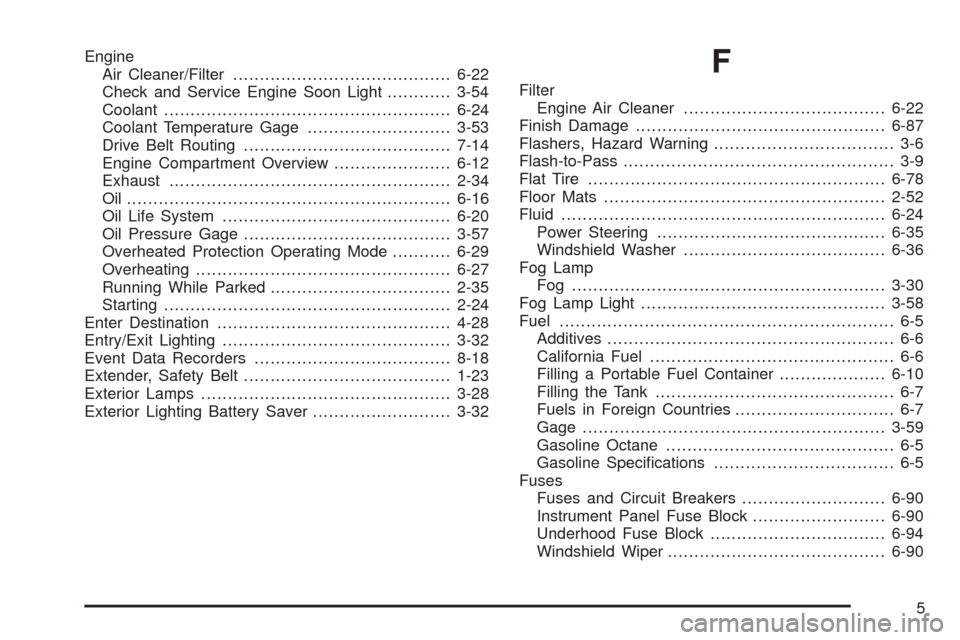check engine light CADILLAC XLR 2008 1.G User Guide
[x] Cancel search | Manufacturer: CADILLAC, Model Year: 2008, Model line: XLR, Model: CADILLAC XLR 2008 1.GPages: 470, PDF Size: 8.39 MB
Page 178 of 470

Emissions Inspection and
Maintenance Programs
Some state/provincial and local governments have
or might begin programs to inspect the emission
control equipment on your vehicle. Failure to pass
this inspection could prevent you from getting a
vehicle registration.
Here are some things you need to know to help
your vehicle pass an inspection:
Your vehicle will not pass this inspection if the check
engine light is on or not working properly.
To perform a check engine light bulb check with the
keyless ignition, make sure the transmitter fob is
in the passenger compartment. SeeIgnition Positions
on page 2-23. Press the bottom of the Acc. button
on the instrument panel and hold the button down for
�ve seconds. The instrument panel, including the check
engine light, will light up and the ignition will be on,but the engine will not start — if you press the bottom
of the Acc. button only brie�y, less than �ve seconds,
the accessory power mode will be turned on, but not
the ignition. After the bulb check, be sure to press and
release the Acc. button again to turn the ignition off
and avoid draining the vehicle’s battery.
Your vehicle will not pass this inspection if the
OBD (on-board diagnostic) system determines that
critical emission control systems have not been
completely diagnosed by the system. The vehicle would
be considered not ready for inspection. This can
happen if you have recently replaced the battery or
if the battery has run down. The diagnostic system is
designed to evaluate critical emission control systems
during normal driving. This may take several days
of routine driving. If you have done this and your
vehicle still does not pass the inspection for lack of
OBD system readiness, your dealer/retailer can prepare
the vehicle for inspection.
3-56
Page 186 of 470

If the driver remains unbuckled when the ignition is
on and the vehicle is in motion, the reminder will
be repeated. If the driver’s safety belt is already buckled,
this message and chime will not come on.
This message is an additional reminder to the Safety
Belt Reminder Light in the instrument panel cluster.
SeeSafety Belt Reminders on page 3-46for more
information.
CHANGE OIL NOW
This message displays when the life of the engine oil
has expired. SeeScheduled Maintenance on page 7-4.
After an oil change, the Oil Life Indicator must be
reset. SeeOil Life Indicator on page 3-80andEngine
Oil Life System on page 6-20.
CHARGE SYSTEM FAULT
This message displays when a problem with the
charging system has been detected. Have your vehicle
serviced by your dealer/retailer.
CHECK GAS CAP
This message displays if the fuel cap has not been
fully tightened. Check the fuel cap to make sure that
it is on properly.
CLEAN RADAR CRUISE
If your vehicle has this feature, this message displays
when the Adaptive Cruise Control (ACC) system is
disabled because the radar is blocked and cannot
detect vehicles in your path. It may also activate during
heavy rain or due to road spray. To clean the system,
seeAdaptive Cruise Control on page 3-15.
CLOSE CARGO DIVIDER
This message displays if the cargo divider is not in
place. Open the trunk and make sure the cargo divider
is secure and no objects are on the divider. See
Rear Storage Area on page 2-53for more information.
COOLANT OVER TEMP (Temperature)
This message displays when the engine coolant
temperature is too hot. Stop and allow your vehicle to
idle in PARK (P) until it cools down and the message
is removed. Do not increase engine speed above
a normal idle. If it does not cool down, turn off the
engine and have your vehicle serviced by your
dealer/retailer before driving it again. Severe engine
damage can result from an overheated engine.
SeeEngine Overheating on page 6-27.
3-64
Page 194 of 470

SERVICE VEHICLE SOON
This message displays when a non-emissions related
powertrain malfunction occurs. Have your vehicle
serviced by your dealer/retailer as soon as possible.
SHIFT TO PARK
This message displays if the vehicle is not in PARK (P)
when the engine is being turned off. The vehicle will
be in accessory mode. Once the shift lever is moved
to PARK (P), the vehicle will turn off.
STABILITRAK ACTIVE
You may see this message on the DIC. It means that
an advanced, computer-controlled system has come on
to help your vehicle continue to go in the direction in
which you are steering. This stability enhancement
system activates when the computer senses that your
vehicle is just starting to spin, as it might if you hit
a patch of ice or other slippery spot on the road.
When the system is on, you may hear a noise or
feel a vibration in the brake pedal. This is normal.When this message is on, continue to steer in the
direction you want to go. The system is designed to
help you in bad weather or other difficult driving situations
by making the most of whatever road conditions will
permit. If this message comes on, you will know that
something has caused your vehicle to start to spin,
so consider slowing down. A single chime also sounds
when this message is displayed.
STABILITRAK READY
If this message displays and a chime sounds, the
system has completed the functional check of the
StabiliTrak
®System.
STABILITRAK WARMING
When you �rst start your vehicle and drive away,
especially during cold winter weather, this message
may display along with a chime and the traction control
warning light. This is normal. You can acknowledge
this message by pressing the RESET button. The
StabiliTrak
®System performance is affected until the
STABILITRAK READY message is displayed in the DIC,
which can take up to 15 minutes.
3-72
Page 297 of 470

Antilock Brake System (ABS)
Your vehicle has the Antilock Brake System (ABS), an
advanced electronic braking system that will help
prevent a braking skid.
When you start the engine and begin to drive away,
ABS will check itself. You might hear a momentary
motor or clicking noise while this test is going on, and
you might even notice that the brake pedal moves
a little. This is normal.
If there is a problem with
ABS, this warning light will
stay on. SeeAntilock
Brake System Warning
Light on page 3-51.
Let us say the road is wet and you are driving safely.
Suddenly, an animal jumps out in front of you. You slam
on the brakes and continue braking. Here is what
happens with ABS:
A computer senses that wheels are slowing down.
If one of the wheels is about to stop rolling, the computer
will separately work the brakes at each wheel.ABS can change the brake pressure faster than any
driver could. The computer is programmed to make the
most of available tire and road conditions. This can
help you steer around the obstacle while braking hard.
As you brake, the computer keeps receiving updates on
wheel speed and controls braking pressure accordingly.
Remember: ABS does not change the time you need to
get your foot up to the brake pedal or always decrease
stopping distance. If you get too close to the vehicle
in front of you, you will not have time to apply the brakes
if that vehicle suddenly slows or stops. Always leave
enough room up ahead to stop, even though you
have ABS.
Using ABS
Do not pump the brakes. Just hold the brake pedal
down �rmly and let antilock work for you. You might hear
a motor or clicking noise and feel the brake pedal
move a little during a stop, but this is normal.
Braking in Emergencies
With ABS, you can steer and brake at the same time.
In many emergencies, steering can help you more than
even the very best braking.
5-5
Page 344 of 470

Automatic Transmission Fluid
How to Check Automatic Transmission
Fluid
It is not necessary to check the transmission �uid level.
A transmission �uid leak is the only reason for �uid
loss. If a leak occurs, take the vehicle to the
dealer/retailer service department and have it repaired
as soon as possible.
There is a special procedure for checking and changing
the transmission �uid. Because this procedure is difficult,
you should have this done at the dealer/retailer service
department. Contact your dealer/retailer for additional
information or the procedure can be found in the service
manual. To purchase a service manual, seeService
Publications Ordering Information on page 8-16.
Notice:Use of the incorrect automatic transmission
�uid may damage your vehicle, and the damages
may not be covered by your warranty. Always
use the automatic transmission �uid listed in
Recommended Fluids and Lubricants on page 7-11.
Change the �uid and �lter at the intervals listed in
Additional Required Services on page 7-5, and be sure
to use the �uid listed inRecommended Fluids and
Lubricants on page 7-11.
Engine Coolant
The cooling system in your vehicle is �lled with
DEX-COOL®engine coolant. This coolant is designed
to remain in your vehicle for �ve years or 150,000 miles
(240 000 km), whichever occurs �rst, if you add only
DEX-COOL
®extended life coolant.
The following explains your cooling system and how to
add coolant when it is low. If you have a problem with
engine overheating, seeEngine Overheating on
page 6-27.
A 50/50 mixture of clean, drinkable water and
DEX-COOL
®coolant will:
Giving freezing protection down to−34°F (−37°C).
Give boiling protection up to 265°F (129°C).
Protect against rust and corrosion.
Help keep the proper engine temperature.
Let the warning lights and gages work as they
should.
Notice:Using coolant other than DEX-COOL
®may
cause premature engine, heater core, or radiator
corrosion. In addition, the engine coolant may
require changing sooner, at the �rst maintenance
service after each 30,000 miles (50 000 km) or
24 months, whichever occurs �rst. Any repairs
would not be covered by your warranty. Always use
DEX-COOL
®(silicate-free) coolant in your vehicle.
6-24
Page 424 of 470

Additional Required Services (cont’d)
Service and Miles (Kilometers)25,000
(40 000)50,000
(80 000)75,000
(120 000)100,000
(160 000)125,000
(200 000)150,000
(240 000)
Engine cooling system service (or every
�ve years, whichever occurs �rst).
An Emission Control Service.
See footnote (g).•
4.4L Supercharged Engine: Intercooler
system service (or every �ve years,
whichever occurs �rst).See footnote (k).•
Inspect engine accessory drive belt.
An Emission Control Service.
See footnote (j).•
Maintenance Footnotes
(a)A fluid loss in any vehicle system could indicate a
problem. Have the system inspected and repaired
and the fluid level checked. Add fluid if needed.
(b)Inspect wiper blades for wear, cracking, or
contamination. Clean the windshield and wiper blades,
if contaminated. Replace wiper blades that are worn
or damaged. See Windshield Wiper Blade Replacement
on page 6-50 and Windshield and Wiper Blades on
page 6-85 for more information.(c)Make sure the safety belt reminder light and safety
belt assemblies are working properly. Look for any other
loose or damaged safety belt system parts. If you see
anything that might keep a safety belt system from doing
its job, have it repaired. Have any torn or frayed
safety belts replaced. Also see Checking the Restraint
Systems on page 1-52.
7-6
Page 459 of 470

Check
Engine Light...............................................3-54
Checking Things Under the Hood......................6-10
Chemical Paint Spotting...................................6-87
Child Restraints
Child Restraint Systems...............................1-30
Infants and Young Children...........................1-26
Lower Anchors and Tethers for Children..........1-32
Older Children.............................................1-23
Securing a Child Restraint in the Right
Front Seat Position...................................1-32
Cigarette Lighter.............................................3-37
Cleaning
Aluminum or Chrome-Plated Wheels..............6-85
Exterior Lamps/Lenses.................................6-84
Fabric/Carpet..............................................6-81
Fiberglass Springs.......................................6-87
Finish Care.................................................6-84
Instrument Panel, Vinyl, and Other
Plastic Surfaces.......................................6-82
Interior.......................................................6-80
Leather......................................................6-82
Speaker Covers..........................................6-82
Tires..........................................................6-86
Underbody Maintenance...............................6-87
Washing Your Vehicle...................................6-83Cleaning (cont.)
Weatherstrips..............................................6-83
Windshield and Wiper Blades........................6-85
Wood Panels..............................................6-82
Climate Control System
Air Filter, Passenger Compartment.................3-42
Dual..........................................................3-38
Outlet Adjustment........................................3-42
Collision Damage Repair..................................8-12
Competitive Driving, Racing or Other.................5-13
Control of a Vehicle.......................................... 5-3
Convenience Net............................................2-53
Coolant
Engine Temperature Gage
............................3-53
Surge Tank Pressure Cap.............................6-27
Cooled Seats................................................... 1-3
Cooling System..............................................6-30
Courtesy Lamps.............................................3-32
Cruise Control................................................3-12
Cupholder(s)..................................................2-52
Customer Assistance Information
Courtesy Transportation................................8-10
Customer Assistance for Text
Telephone (TTY) Users............................... 8-5
Customer Assistance Offices........................... 8-5
Customer Satisfaction Procedure..................... 8-2
3
Page 461 of 470

Engine
Air Cleaner/Filter.........................................6-22
Check and Service Engine Soon Light............3-54
Coolant......................................................6-24
Coolant Temperature Gage...........................3-53
Drive Belt Routing.......................................7-14
Engine Compartment Overview......................6-12
Exhaust.....................................................2-34
Oil .............................................................6-16
Oil Life System...........................................6-20
Oil Pressure Gage.......................................3-57
Overheated Protection Operating Mode...........6-29
Overheating................................................6-27
Running While Parked..................................2-35
Starting......................................................2-24
Enter Destination............................................4-28
Entry/Exit Lighting...........................................3-32
Event Data Recorders.....................................8-18
Extender, Safety Belt.......................................1-23
Exterior Lamps...............................................3-28
Exterior Lighting Battery Saver..........................3-32F
Filter
Engine Air Cleaner......................................6-22
Finish Damage...............................................6-87
Flashers, Hazard Warning.................................. 3-6
Flash-to-Pass................................................... 3-9
Flat Tire........................................................6-78
Floor Mats.....................................................2-52
Fluid.............................................................6-24
Power Steering...........................................6-35
Windshield Washer......................................6-36
Fog Lamp
Fog ...........................................................3-30
Fog Lamp Light..............................................3-58
Fuel............................................................... 6-5
Additives...................................................... 6-6
California Fuel.............................................. 6-6
Filling a Portable Fuel Container....................6-10
Filling the Tank............................................. 6-7
Fuels in Foreign Countries.............................. 6-7
Gage.........................................................3-59
Gasoline Octane........................................... 6-5
Gasoline Speci�cations.................................. 6-5
Fuses
Fuses and Circuit Breakers...........................6-90
Instrument Panel Fuse Block.........................6-90
Underhood Fuse Block.................................6-94
Windshield Wiper.........................................6-90
5
Page 462 of 470

G
Gage
Engine Coolant Temperature.........................3-53
Engine Oil Pressure.....................................3-57
Fuel..........................................................3-59
Speedometer..............................................3-45
Tachometer.................................................3-45
Voltmeter Gage...........................................3-50
Garage Door Opener.......................................2-44
Gasoline
Octane........................................................ 6-5
Speci�cations............................................... 6-5
Getting Started
Getting Started, Navigation............................. 4-4
Global Positioning System (GPS)......................4-50
Glove Box.....................................................2-52
GM Mobility Reimbursement Program.................. 8-7
H
Hazard Warning Flashers................................... 3-6
Headlamp
Aiming.......................................................6-47
Vertical Aiming............................................6-48Headlamps
Adaptive Forward Lighting System.................3-30
Bulb Replacement.......................................6-50
Daytime Running Lamps...............................3-29
Exterior Lamps............................................3-28
Flash-to-Pass............................................... 3-9
High/Low Beam Changer................................ 3-9
On Reminder..............................................3-29
Washer......................................................3-12
Wiper Activated...........................................3-29
Head-Up Display (HUD)...................................3-33
Heated Seats................................................... 1-3
Heated Steering Wheel..................................... 3-7
Heater...........................................................3-38
Highbeam On Light.........................................3-58
Highway Hypnosis...........................................5-16
Hill and Mountain Roads..................................5-16
Hood
Checking Things Under................................6-10
Release.....................................................6-11
Horn............................................................... 3-6
How to Wear Safety Belts Properly...................1-11
6
Page 467 of 470

Rearview Mirror, Automatic Dimming
with OnStar®..............................................2-36
Reclining Seatbacks, Power............................... 1-4
Recommended Fluids and Lubricants.................7-11
Recreational Vehicle Towing.............................5-27
Remote, Keyless Access System................2-5, 4-50
Replacement, Windshield.................................6-50
Reporting Safety Defects
Canadian Government..................................8-15
General Motors...........................................8-16
United States Government............................8-15
Restraint System Check
Checking the Restraint Systems....................1-52
Replacing Restraint System Parts
After a Crash..........................................1-53
Retained Accessory Power (RAP)......................2-24
Retractable Hardtop........................................2-54
Lowering....................................................2-54
Raising......................................................2-55
Roadside
Service........................................................ 8-7
Rocking Your Vehicle to Get it Out....................5-22
Route Preference............................................4-37
Routing, Engine Drive Belt...............................7-14
Run-Flat Tires................................................6-58
Running the Engine While Parked.....................2-35S
Safety Belt
Reminder Light............................................3-46
Safety Belts
Care of......................................................6-83
How to Wear Safety Belts Properly................1-11
Lap-Shoulder Belt........................................1-20
Safety Belt Extender....................................1-23
Safety Belt Use During Pregnancy.................1-22
Safety Belts Are for Everyone......................... 1-6
Safety Warnings and Symbols.............................. iv
Scheduled Maintenance..................................... 7-4
Seats
Heated and Cooled Seats.............................. 1-3
Memory, Mirrors............................................ 1-3
Power Lumbar.............................................. 1-2
Power Reclining Seatbacks............................. 1-4
Power Seats................................................. 1-2
Securing a Child Restraint
Right Front Seat Position..............................1-32
Security Light.................................................3-58
Service........................................................... 6-3
Accessories and Modi�cations......................... 6-3
Adding Equipment to the Outside
of Your Vehicle.......................................... 6-4
11